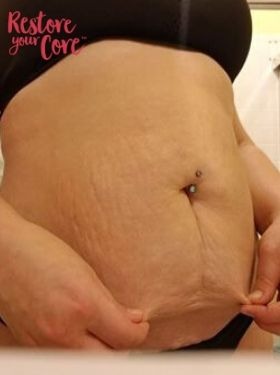Umbilical hernias are one of the most usual sort of rupture while pregnant and happen right at your stubborn belly button, when your intestinal tracts bulge through the front of the abdominal wall. In an umbilical hernia, part of the intestinal tract or stomach tissue protrudes with or near the navel, creating a lump. It occurs when muscle mass near the stomach switch do not close correctly after birth, creating a weak point in the abdominal wall surface. A rupture is a tiny hole in the stomach wall surface, which generally holds your tissues and organs-- including your stomach as well as intestinal tracts-- tightly inside you. An umbilical hernia occurs when component of a kid's intestinal tracts protrudes with the abdominal wall surface inside the belly switch. The hernia isn't unpleasant and the majority of do not cause any type of issues. When there is boosted stress on the stomach wall, like with maternity, intense pressure or weight gain, it can damage the cells or fascia between the abdominal muscles.
Can you get a hernia from trying to poop?
Any activity or medical problem that increases pressure on the tissue in the belly wall and muscles may lead to a hernia, including: Long-term (chronic) constipation and pushing hard (straining) to have a bowel movement.
Many commonly, individuals with hernias see a swelling or inflammation and also pressure or discomfort upon flexing, coughing, or straining. The lump might be less complicated to feel when the person stands. This suggests a reducible rupture, suggesting it can be pressed back into the abdomen. When an individual stands, the lump sticks out visibly because of the pull of gravity. An umbilical rupture happens when part of your intestine protrudes via the opening in your stomach muscles near your bellybutton.
Q: Just How Are Hernias Treated?
If left untreated, these hernias can shed blood supply, harming your intestines, so you might need extra aggressive treatment or surgical treatment. An umbilical hernia is an abnormal lump that can be seen or felt at the how long does diastasis recti take to heal umbilicus. This rupture establishes when a part of the lining of the abdominal area, component of the intestine, and also/ or fluid from the abdominal area, comes with the muscular tissue of the abdominal wall surface. An abdominal hernia is an opening or weak point in the muscular framework of the wall of the abdominal area. diastasis recti in pregnancy The abdominal muscle sticks out through the opening and also this problem triggers a bulging of the stomach wall surface. This bulging is usually more recognizable when the abdominal muscles are tightened, therefore raising the stress in the abdomen.
Can stomach tumor be cured?
Many cases of stomach cancer can't be completely cured, but it's still possible to relieve symptoms and improve quality of life using chemotherapy and in some cases radiotherapy and surgery. If operable, surgery can cure stomach cancer as long as all of the cancerous tissue can be removed.
The materials of the lump or lump may be intestine or fatty tissue. Often this lump in the stomach wall surface is described as an outpouching. If the pressure inside the abdomen boosts, similar to a cough or lifting a hefty object, the hernia can show up.
Symptoms And Signs Of Umbilical Rupture.

Because they have a tendency to expand bigger in time, umbilical ruptures need treatment. Treatment commonly includes surgical procedure, but your doctor will certainly discuss all your options with you carefully. Without treatment, you go to danger of creating a strangulated rupture, which implies that blood supply to the tissue has actually been cut off. Strangulation is life threatening and needs emergency situation surgery.
When I lean back there is a bulge in my stomach?

Diastasis recti occurs when too much pressure is put on your abdominal muscles. This can cause them to stretch and http://milowwbg969.huicopper.com/diastasis-recti-signs-and-symptoms separate. The separation in the muscles allows what's inside of the abdomen, mostly the intestines, to push through the muscles. This forms a bulge.